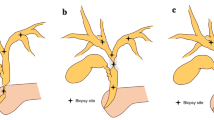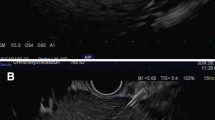Abstract
Purpose
To evaluate the efficacy of percutaneous biopsy for diagnosing intrahepatic cholangiocarcinoma (IHCCA).
Methods
Retrospective review of biopsy and pathology databases from 2006 to 2019 yielded 112 patients (54F/58 M; mean age, 62.9 years; 27 cirrhotic) with IHCCA who underwent percutaneous biopsy. Data regarding the lesion, biopsy procedure technique, and diagnostic yield were collected. If biopsy was non-diagnostic or discordant with imaging, details of repeat biopsy or resection/explant were gathered. A control group of 100 consecutive patients (56F/44 M; mean age, 63 years, 5 cirrhotic) with focal liver lesions > 1 cm was similarly assessed.
Results
Mean IHCCA lesion size was 6.1 ± 3.6 cm, with dominant lesion sampled in 78% (vs. satellite in 22%). 95% (n = 106) were US guided and 96% were core biopsies (n = 108), typically 18G (n = 102, 91%), median 2 passes. 18 patients (16%) had discordant/ambiguous pathology results requiring repeat biopsy, with two patients requiring 3–4 total attempts. A 4.4% minor complication rate was seen. Mean time from initial biopsy to final diagnosis was 60 ± 120 days. Control group had mean lesion size of 2.9 ± 2.5 cm and showed a non-diagnostic rate of 3.3%, both significantly lower than that seen with CCA, with average time to diagnosis of 21 ± 28.8 days (p = 0.002, p = 0.001).
Conclusion
IHCCA is associated with lower diagnostic yield at initial percutaneous biopsy, despite larger target lesion size. If a suspicious lesion yields a biopsy result discordant with imaging, the radiologist should recommend prompt repeat biopsy to prevent delay in diagnosis.
Graphic abstract





Similar content being viewed by others
References
Mantripragada S, Chawla A. Cholangiocarcinoma: Part 1, Pathological and Morphological Subtypes, Spectrum of Imaging Appearances, Prognostic Factors and Staging. Curr Probl Diagn Radiol 2021;
Saleh M, Virarkar M, Bura V, et al. Intrahepatic cholangiocarcinoma: pathogenesis, current staging, and radiological findings. Abdom Radiol (NY) 2020; 45:3662-3680
Joo I, Lee JM, Yoon JH. Imaging Diagnosis of Intrahepatic and Perihilar Cholangiocarcinoma: Recent Advances and Challenges. Radiology 2018; 288:7-13
Rhee H, Kim MJ, Park YN, An C. A proposal of imaging classification of intrahepatic mass-forming cholangiocarcinoma into ductal and parenchymal types: clinicopathologic significance. Eur Radiol 2019; 29:3111-3121
Seo N, Kim DY, Choi JY. Cross-Sectional Imaging of Intrahepatic Cholangiocarcinoma: Development, Growth, Spread, and Prognosis. AJR Am J Roentgenol 2017; 209:W64-W75
Choi SH, Jeon SK, Lee SS, et al. Radio-pathologic correlation of biphenotypic primary liver cancer (combined hepatocellular cholangiocarcinoma): changes in the 2019 WHO classification and impact on LI-RADS classification at liver MRI. Eur Radiol 2021;
Kim DH, Choi SH, Kim DW, et al. Combined Hepatocellular-Cholangiocarcinoma: Magnetic Resonance Imaging Features and Prognosis According to Risk Factors for Hepatocellular Carcinoma. J Magn Reson Imaging 2021; 53:1803-1812
Kim EJ, Yoo C, Kang HJ, et al. Clinical outcomes of systemic therapy in patients with unresectable or metastatic combined hepatocellular-cholangiocarcinoma. Liver Int 2021; 41:1398-1408
Rizvi S, Gores GJ. Emerging molecular therapeutic targets for cholangiocarcinoma. J Hepatol 2017; 67:632-644
Abou-Alfa GK, Macarulla T, Javle MM, et al. Ivosidenib in IDH1-mutant, chemotherapy-refractory cholangiocarcinoma (ClarIDHy): a multicentre, randomised, double-blind, placebo-controlled, phase 3 study. Lancet Oncol 2020; 21:796-807
Abou-Alfa GK, Sahai V, Hollebecque A, et al. Pemigatinib for previously treated, locally advanced or metastatic cholangiocarcinoma: a multicentre, open-label, phase 2 study. Lancet Oncol 2020; 21:671-684
Silverman IM, Hollebecque A, Friboulet L, et al. Clinicogenomic Analysis of FGFR2-Rearranged Cholangiocarcinoma Identifies Correlates of Response and Mechanisms of Resistance to Pemigatinib. Cancer Discov 2021; 11:326-339
Domagk D, Poremba C, Dietl KH, et al. Endoscopic transpapillary biopsies and intraductal ultrasonography in the diagnostics of bile duct strictures: a prospective study. Gut 2002; 51:240-244
Naitoh I, Nakazawa T, Kato A, et al. Predictive factors for positive diagnosis of malignant biliary strictures by transpapillary brush cytology and forceps biopsy. J Dig Dis 2016; 17:44-51
Trikudanathan G, Navaneethan U, Njei B, Vargo JJ, Parsi MA. Diagnostic yield of bile duct brushings for cholangiocarcinoma in primary sclerosing cholangitis: a systematic review and meta-analysis. Gastrointest Endosc 2014; 79:783-789
Jung GS, Huh JD, Lee SU, Han BH, Chang HK, Cho YD. Bile duct: analysis of percutaneous transluminal forceps biopsy in 130 patients suspected of having malignant biliary obstruction. Radiology 2002; 224:725-730
Park JG, Jung GS, Yun JH, et al. Percutaneous transluminal forceps biopsy in patients suspected of having malignant biliary obstruction: factors influencing the outcomes of 271 patients. Eur Radiol 2017; 27:4291-4297
Sacks D, McClenny TE, Cardella JF, Lewis CA. Society of Interventional Radiology clinical practice guidelines. J Vasc Interv Radiol 2003; 14:S199-202
Rompianesi G, Di Martino M, Gordon-Weeks A, Montalti R, Troisi R. Liquid biopsy in cholangiocarcinoma: Current status and future perspectives. World J Gastrointest Oncol 2021; 13:332-350
Funding
None.
Author information
Authors and Affiliations
Corresponding author
Ethics declarations
Conflict of interest
Meghan G. Lubner received prior grant funding from Ethicon and Philips. Shane A. Wells declares that he is a consultant in Ethicon. Timothy J. Ziemlewicz declares that he is a consultant in Ethicon and Histosonics. Sam J. Lubner has a new disclosure, now serving as a consultant and shareholder for Elephas. Perry J. Pickhardt declares that he is an advisor to Bracco and is a shareholder in Elucent, SHINE, and Cellectar Biosciences.
Additional information
Publisher's Note
Springer Nature remains neutral with regard to jurisdictional claims in published maps and institutional affiliations.
Rights and permissions
About this article
Cite this article
Lubner, M.G., Larison, W.G., Watson, R. et al. Efficacy of percutaneous image-guided biopsy for diagnosis of intrahepatic cholangiocarcinoma. Abdom Radiol 47, 2647–2657 (2022). https://doi.org/10.1007/s00261-021-03278-3
Received:
Revised:
Accepted:
Published:
Issue Date:
DOI: https://doi.org/10.1007/s00261-021-03278-3




